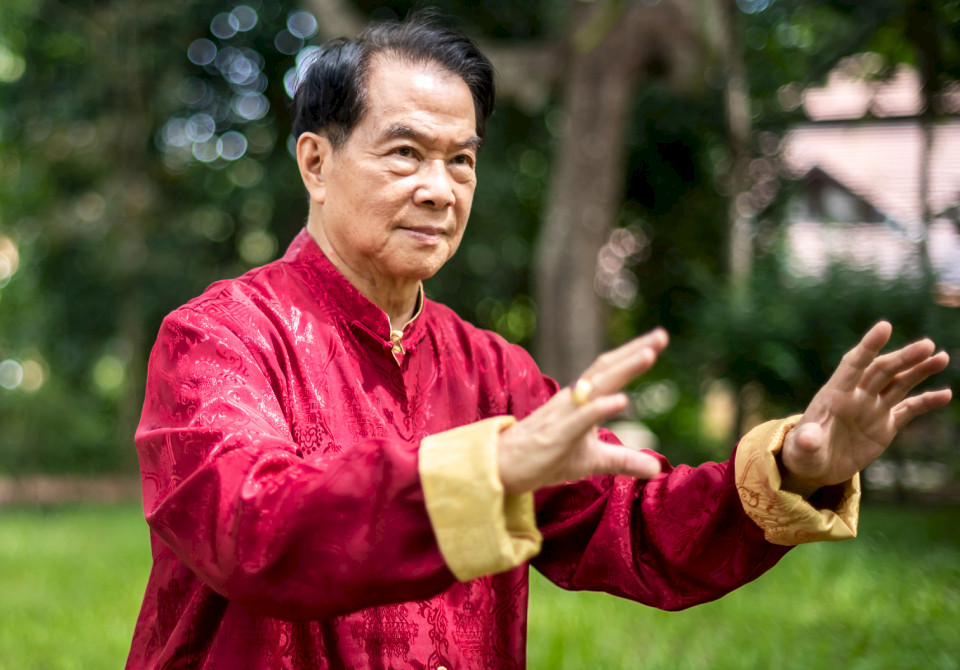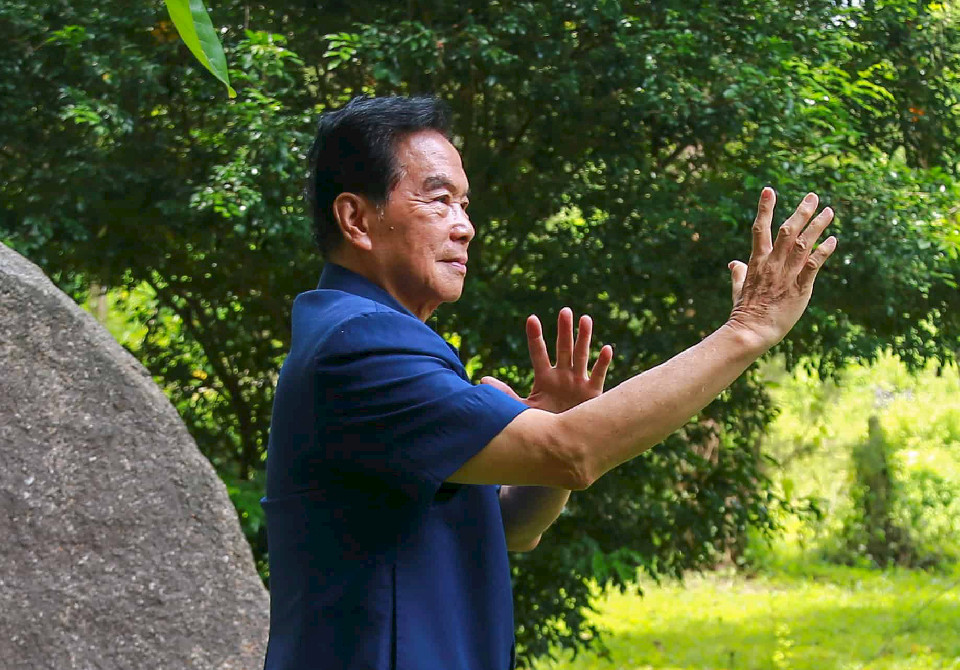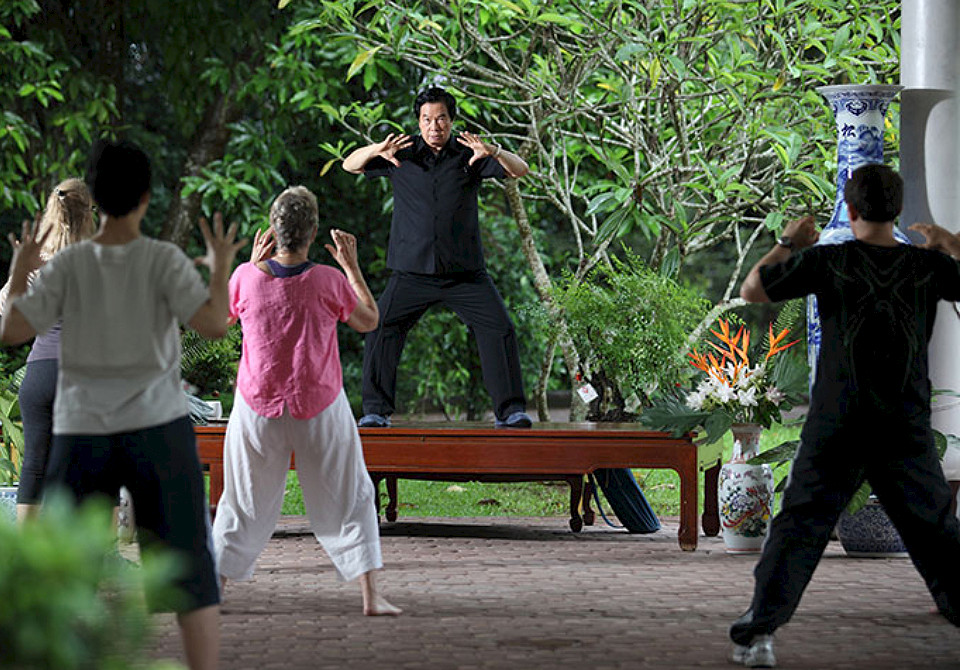
The Tai Chi Chi Kung form emphasises the internal structure of Tai Chi: the way the Chi flows through the body and how the energy rises from the earth and is guided through the skeleton. This form is easy to learn and yet contains all the essential techniques of Tai Chi Kung.
As most masters in the past taught the long Tai Chi form with 108 movements, it was tedious and time-consuming for practitioners to learn. In many cases, it took years before they could 'walk' the form without instruction and only then could they begin to explore the inner structure of Tai Chi.
With this short and essential Tai Chi Kung 13 Yang Style form, the practitioner can very quickly begin to apply the basic principles of Tai Chi: absorbing, transforming and directing the Three Forces.
The Three Forces are the Heavenly Force (force of the universe), which emanates from the stars, the sun and the moon; the Cosmic Force, which emanates from the particles in the earth's atmosphere and outer space; and the Earth Force, which emanates from Mother Earth herself. The principles of Tai Chi and the methods for developing internal structure can be applied to all styles of Tai Chi Chuan. Many different areas of the Taoist exercise system are touched upon and utilised in Tai Chi Kung.

Today we find countless Tai Chi styles worldwide. Regardless of the style, the first step for the student is to learn the external Tai Chi movements and memorise them in the body. If you then perform these movements in sequence, this is called walking the Tai Chi form. Once you have learnt the outer form, you begin to work on the inner form. This inner work is what makes Tai Chi Chi Kung special and distinguishes it from the outer forms of martial arts. Internal structure refers to what makes it possible for the body to move as a whole. Those who do not touch this inner aspect of Tai Chi are behaving as if they were not looking inside the oyster in search of the pearl.

Energy meditation is the foundation for mastering the internal structure. Many Tai Chi students around the world do not receive any instruction in energy meditation and unfortunately most practitioners have to learn long and difficult Tai Chi forms first. Therefore, they have to go through many years of practice and correction before they can master the external form and perform it beautifully. Because of the time required to learn the long, outer forms, the internal work is often neglected.
We learn to root ourselves in the earth force in Iron Shirt Chi Kung and to build up inner strength in Tan Tien Chi Kung. We achieve the opening of the body to the chi flow (the breath of the dragon) in the practice of Tao Yin. The connection with the Heavenly Power and the Cosmic Power is taught in the basic practices of Inner Alchemy and further advanced in Cosmic Healing Chi Kung.

Tai Chi Chi Kung 1 - Yang Style
As the name suggests, a simple Yang-Style form with thirteen positions. The eight forces of Pakua, the eight directions in space, the balance in the Yin and Yang flow of Chi in the body, the rooting and alignment to the earth and the cosmos, the awakening of the three Tan Tiens and the conscious use of the Chi awakened in movement to vitalise our diverse body cells.
Our focused awareness during Tai Chi practice - our Yi - is trained, our body is flowed through, our mind becomes more alert. The Tai Chi must grow in your body, the speed of growth depends on your abilities, your training hours and your accompanying and guiding teacher. You can learn the visible Tai Chi 1 form within 1-3 months.
After that, the main work can begin to activate your inner body alchemy, open your meridians, your joints, your whole energy system. What your eyes can see is only, let's say, the externally visible 20-30%. The main part of Tai Chi involves the internal processes. A calm mind, physical flexibility, co-ordinated interplay of movement and breath and thus control of the chi flow. The act of equalising balance, the highest goal of classical Chinese medicine.
Tai Chi has its roots primarily in martial arts, while Qigong is derived from Chinese medicine. However, both utilise roughly the same principles. A kind of dynamic meditation, the conscious linking of breath with movement and thus the control of the chi flow in the body. In simple terms, Tai Chi could be seen as an organised sequence of Qigong exercises.
In order to develop these invisible inner alchemy qualities, we all need patience, corrections and repeated practice. Previous knowledge from other schools, such as martial arts, yoga or all variants of Qigong, makes training easier and shortens the learning time.

Tai Chi Chi Kung 2 - Discharging Form with Fa Jing Elements
The inner body alchemy is activated, the meridians, the joints, the whole energy system is opened. What the eyes see is only a small part in the form of the externally perceptible sequence of movements. The main part of Tai Chi is the internal processes. A calm mind, physical flexibility, a coordinated interplay of movement and breath and thus control over the flow of chi. The act of balance, the highest goal of classical Chinese medicine.
The roots of Tai Chi lie more in martial arts, while Qigong is derived from Chinese medicine. However, both utilise the same principles. A kind of dynamic meditation that consciously links the breath with movement and thus controls the flow of chi in the body. Put simply, Tai Chi could be seen as an organised sequence of Qigong exercises.
Developing these invisible inner alchemical qualities requires patience, correction and repeated practice. Previous knowledge of other schools, such as martial arts, yoga or all variants of Qigong, makes training easier and shortens the learning time.
The visible Tai Chi form can be learnt within 1-3 months. The Tai Chi must grow in the body, the speed of growth depends on personal ability, the number of training hours and the teacher.

Tai Chi Chi Kung 3 - Wu Style
Tai Chi is the crème de la crème of physical exercises, it can awaken the spiritual consciousness in our physical body. Our cells, tendons, muscles, organs - even our brain and nerves begin to vibrate at higher levels. Through the increased flow of chi, our senses can penetrate into deeper layers of perception.
Our focussed awareness during Tai Chi practice - our Yi - is trained, our body is flushed, our mind becomes more alert. The Tai Chi has to grow in your body, the speed of growth depends on your abilities, your training hours and your accompanying and guiding teacher. You can learn the visible Tai Chi 1 form within 1-3 months, after which the main work can begin to activate your inner body alchemy, to open your meridians, your joints, your whole energy system.
What your eyes can see is only, let's say, the externally visible 20-30%. The main part of Tai Chi involves the internal processes. A calm mind, physical flexibility, coordinated interplay of movement and breath and thus control of the chi flow. The act of equalising balance, the highest goal of classical Chinese medicine. The roots of Tai Chi lie primarily in martial arts, while Qigong is derived from Chinese Medicine. However, both utilise the same principles. A kind of dynamic meditation, the conscious linking of breath with movement and thus the control of the flow of chi in the body.
Put simply, Tai Chi could be seen as an organised sequence of Qigong exercises. In order to develop these invisible inner alchemy qualities, each of us needs patience, corrections and repeated practice. Previous knowledge of other schools, such as martial arts, yoga or all variants of Qigong, makes training easier and shortens the learning time. The less frequently practised Wu-style Tai Chi originated from the Yang style. Its founder Wu Chuan-Yu (1834-1902) modified the Yang-style forms learnt by Yang Lu Chan's son Yang Pan-Hou (1837-1892). The advantages over the more commonly taught Yang style are its more natural postures and movements.
In contrast to the Yang style, in the Wu style the spine can be slightly bent forwards and the posture can be higher. This allows for easier control and flow of chi (life energy) and jin (internal force). The Wu style allows students of all ages and abilities to learn and master this short form relatively quickly and still touch the essence of the principles and embed them in the body over time of practice. The techniques presented in this workshop have been passed down from generation to generation over hundreds of years and are practical methods to improve physical, emotional and mental health.
Developed by Taoist Grand Master Mantak Chia, the Wu Tai Chi style is a simple method to cultivate both chi (life energy) and jin (internal force) fluently throughout the body. Dr Andrew Jan is an emergency physician and holds Masters degrees in medicine and philosophy, is a TCM doctor and yoga teacher. As UHT Senior Instructor and co-author with Mantak Chia of currently 6 books on Martial Arts, Tai Chi and the higher Inner Alchemy practices Kan & Li, he has been instrumental in the development of the UHT Internal Martial Arts Branch.
Book recommendation: Tai Chi Wu Style: Advanced Techniques for Internalising Chi Energy by Mantak Chia and Andrew Jan (21-Feb-2013) Paperback
